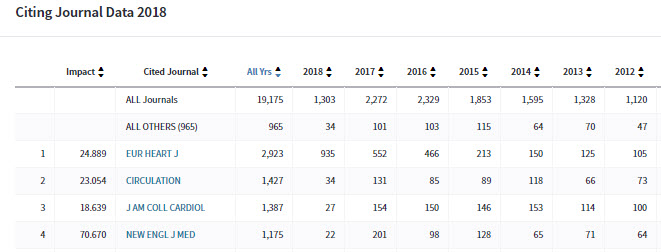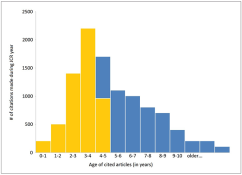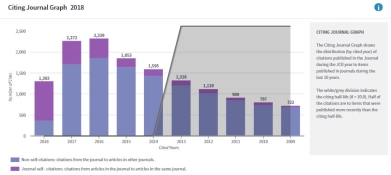Citing Journal Data
Citing Half-Life Data
The Citing Half-Life is the median age of the citations produced by a journal during the JCR year. A citation’s age is equal to the publication year of the citing item (i.e., JCR year) minus the publication year of the cited item. By definition, half of a journal's outbound citations are to items published before the Citing Half-Life, and half are to items published after the Citing Half-Life. In the example histogram, a journal produced 10,500 citations during the JCR year (the JCR year is the period marked 0-1; the year prior is the period marked 1-2; and so on). The Citing Half-Life is 4.6, meaning the median age of the citations is 4.6 years old. Half of the citations are to items that are newer than 4.6 years old (orange zone), and half are to items that are older (blue zone).
For all JCR data years prior to 2017, the maximum Citing Half-Life that will be displayed in the Key Indicators table is 10 years. Any value greater than this will be displayed as >10.0.
In 2017 data and for all subsequent years, the Citing half-life metric is calculated to a resolved value. Citing half-life shows how each journal interacts with the published literature of its field. Journals with a high Citing half-life are citing more of the deep, archival materials in their field in the current JCR year. This indicates that older literature is still actively contributing to current scholarship.
|
|
The above histogram is provided for explanatory purposes and is not available in Journal Citation Reports |
The Citing Half-Life data table will display information beginning with the current JCR year and extend back an additional nine years, with further historical cited years noted in the final column. Scroll to the right to see all years. Only journals with 100 or more outgoing citations in the JCR year have a Citing Half-Life.
Citing Journal Graph
The Citing Journal Graph shows the distribution by cited year of citations from articles in the selected journal. All of the citing articles were published in the JCR year.
- The white/grey division indicates the Citing Half-Life (if < 10.0 years). Half of the citations from the journal's current articles are to articles published more recently than the Citing Half-Life.
- The top (yellow) portion of each column indicates journal self - citations: citations from articles in the journal to articles in the same journal.
- The bottom (blue) portion of each column indicates non-self-citations: citations from the journal to articles in other journals.
Citing Journal Data
The Citing Journal table lists journals cited by the journal identified at the top of the page. In the table below, the citing journal is Plant Pathology, and all of the citing articles were published in 2012. The journals cited by articles in Plant Pathology are listed in the Cited Journal column.

How to Read the Citing Journal Table
| Impact | The impact factor of the cited journal. |
| Cited Journal |
The abbreviated title of the cited journal. Click the title to go to the full record (Journal page) of the journal. Cited journals are sorted in descending order, from most cited to least cited. The numbers in the All Journals row are sums of the numbers in their respective columns. ALL OTHERS refers to 1) citing journals not listed by name in the table and 2) journals cited only once by the cited journal. If the number of cited journals is less than 25, all cited titles are listed. If there are more than 25 cited titles, all titles cited two or more times are listed individually. Titles cited only once are listed in alphabetical order until the total number of cited titles is at least 25; all other titles cited only once are collected in the ALL OTHERS category |
| Cited Year: All Years | The total number of citations to the cited journal. This total includes the number shown under each year and the number in the Rest column. |
| Cited Year: Individual Years |
The publication year of the cited articles. |
| Cited Year: Rest |
All publication years of cited articles prior to the 10-year period defined by the table. For example, if the cited years shown are 2012-2003, the Rest column displays the number of citations from the citing journal in 2012 to articles published in 2002 and earlier in the cited journal. Clicking any journal title in the table takes you directly to that journal's profile page. |
| Non-traditional Items | Items marked as Non-Traditional are those items of a non-researched nature, such as press releases, legal proceedings, or government documents. |


